Final report for FNC14-974
Project Information
Northeast Minnesota is home to a large beef cow-calf sector, several dairy farms and an increasing amount of cash grain farming. In each of these types of operations, annual cultivation of corn, soybeans, oats and barley is common. Unfortunately, annual cultivation of these crops leads to high rates of nutrient leaching and soil erosion, decreased crop diversity, decreased soil aggregate stability, decreased soil organic matter and reduced soil biology and overall soil health. The utilization of cover crops has been shown in many cases to alleviate these problems. Carlton County Extension office has conducted a variety of cover crop educational research and education efforts. This project has built upon previous efforts by putting cover crop demonstration sites on three farms, in three different adjacent counties in Northeast Minnesota. Three field days have been hosted on-site over the 2 years providing information to a variety of audiences as well as opportunities in the future. Soil nutrients and soil biology have been monitored through using soil testing, forage yields and expenses have been tracked and summarized. This is the final report for the grant term.
Introduction:
The 2014 SARE Farmer/Rancher Grant was a group project which included three cooperating farmers, each from different counties. The farmers include Scott Peterson of St. Louis County; Troy Salzer, University of Minnesota Extension Educator of Carlton County and farmer; and Abe Mach of Pine County.
Two agricultural problems in northeastern Minnesota were addressed by this project:
- Though the implementation of cover crops is vastly expanding throughout the United States, northeastern Minnesota has been slow to adopt the practice. This is largely due to farmer skepticism that our cooler climate can accommodate cover crops and lack of education on how to successfully grow them in an economically beneficial fashion.
- Due to northeastern Minnesota’s relatively short growing season, the cost of winter feeding stored feeds greatly reduces profit margins for cow/calf operators.
The objective of the project was to demonstrate how cover crops can be implemented in northern Minnesota’s climate and agricultural industry. The strategy by which cover crops was implemented was planting a small grain (oats, barley, or wheat), mechanically harvesting it in early August, and immediately planting a cover crop cocktail consisting of peas, forage turnips, and winter rye. The goal was to produce enough forage in the cover crop to be able to get a late fall grazing. Several objectives were identified and included:
- Can cover crops be successfully grown in a northern Minnesota climate?
- Is the quality of the cover crops substantial enough to extend the grazing season for grass finished cattle?
- Can enough forage be produced to justify the cost of seeding?
- Can the nutrient retention in the soil be impacted to reduce environmental losses?
- Does the utilization of cover crops increase soil organic matter?
- Does growing cover crops impact soil biology (soil health)?
Cooperators
Research
The design of this project was that Northeast Minnesota farmers, Troy Salzer, Abe Mach, and Scott Peterson, would grow a small grain crop and then no-till plant a fall cover crop after the small grain in order to increase forage production and incorporate late season cover crops into an annual crop rotation. Each of the farmers planted different types of crops. Salzer grew peas and oats for grazing forage, Peterson grew corn harvested by grazing and Mach allowed winter rye (planted in fall of 2014 as part of this project) to regrow and harvested by baling. (See Timeline)
The project utilized 10 acres for a test plot and 10 acres for a control plot at each cooperating farm and took place over two years. Soil samples were collected each fall for analysis of total N, P, K, pH, OM, and total biology (aerobic and anaerobic). Also cover crop samples will be collected for analysis of protein, dry matter, and yield. Forage data was used to determine a market value of the cover crop, which will help determine whether this type of cover cropping scenario is financially viable for farmers in the area.
Grant activities began in May 2014 and were completed in December 2015. Soil testing was conducted at each of the sites in order to create a “before” picture of soil nutrient availability. The results were used by the farmer to fertilize appropriately for the small grain crop.
In August 2014, all three of the farmers harvested the small grain crop. At two of the sites the small grain was harvested as baleage. At one of the sites the small grain was grazed. No additional fertilizer was applied between harvest of the small grain and planting of the cover crop. Cover crops were planted at each of the sites between August 11, 2014 and August 23, 2014. Shortly after planting, Abe Mach’s site, which had good highway visibility, was marked with a highway sign identifying it as an NCR-SARE cover crop research plot. Literature handouts about soil health and this specific Farmer/Rancher Grant Project were placed in a clear box fixed to the sign for the public to take.
The bulk of the data collection took place 11/10/14 through 11/15/2014. During this period soil samples were collected at all of the sites from the cover crop plots as well as adjacent control plots. Soil samples were submitted to Agvise Laboratories where soil nutrients were analyzed as well as CO2 (soil biology). Also at that time, forage samples were collected from the cover crop. Forage samples were collected by scissor clipping five to six, 1 square foot plots at each of the sites. The samples were then dried to calculate dry matter yields (tons DM/acre). The dried samples were then sent into Agvise Laboratories for forage quality analyses.
In 2015, following harvest of the forage (grazing or baling) the sites were top-dressed with fertilizer at the following rates based on previous soil tests:
|
Product/acre |
Fertilizer Cost/acre |
Seed Cost/acre |
TOTAL Cost/acre |
Cost/ ton |
Salzer |
100# AMS |
$21.60 |
$32.70 |
$54.30 |
$23.81 |
Mach |
30# AMS plus 100# potash |
$32.62 |
$32.70 |
$65.32 |
$48.74 |
Peterson |
30# AMS plus 100# potash |
$32.62 |
|
|
|
|
(AMS was used to avoid Nitrogen volatilization) |
|
|
|
|
Abe Mach’s site utilized winter rye regrowth that was cut and baled on August 20, 2015 and on August 22nd, 2015 a cover crop was planted. The cover crop was not harvested in 2015. At the other two farms, oats and peas were planted in June 2015. At the Peterson farm the crop was cut in early September and at the Salzer farm the crop was grazed in mid-August.
Seeding was achieved by utilizing a no-till drill (Salzer & Peterson) or by including the seed with fertilizer, spread material on the field and lightly disking and dragging to get good soil to seed contact (Mach). The target seed depth was ½ inch, which is a little too deep for turnips and a little too shallow for winter rye. In all cases, the process was followed by sufficient rain event to set the soil to seed as well as incorporate top dressed fertilizer. All of the sites received adequate to excessive rainfall amounts with a well-above average temperature and did not see a killing frost for cold crops like winter rye and turnips until December 14, 2015.
The yield data was collected at each site by using a 1 foot square randomly tossed in the field in six spots in the treatment area. The samples were clipped and placed in airtight bags, weighed and held in a freezer until dry matter analysis could be performed. At the same time, forage samples were also collected and sent in for analysis. This collection was taken from a sub-sample of the six collective sites and combined in to one sample for analysis. Additionally, a soil sample was collected from the treatment site and the control site (no cover crops). The soil samples were collected using a soil probe to a depth of 6 inches at 12-15 random spots in the respective area. Due to the very poor establishment at Peterson’s site and virtually no difference in treatment versus control, we only collected one sample for soil analysis.
Weather was also a factor with this project. At the Mach and Salzer sites, they received adequate to excessive rainfall during the extended fall with well above normal temperatures. Their soil types allowed the soil types (loamy sand and sandy loam, respectively) to absorb the rainfall before the next rain event, however at the Peterson site, the excessive rain combined with his silty soil did not allow for absorption before the next rain event. This along with a late planting (9/23/15) following the corn crop grazing did not give the seed an opportunity for success. Due to this data and farmer projects, our suggestion is to encourage a planting date target in early to mid-August. It also may not be feasible when corn is being grown unless the harvest is very early in the season.
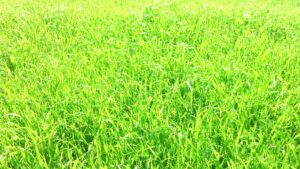
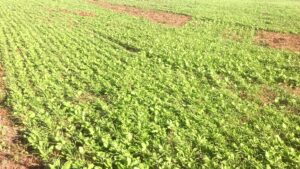
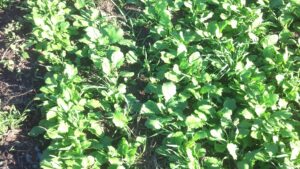
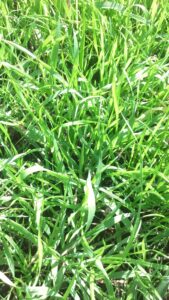
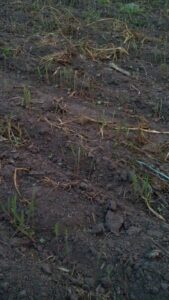
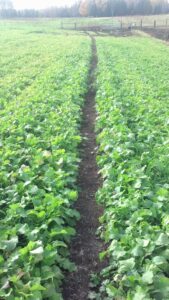

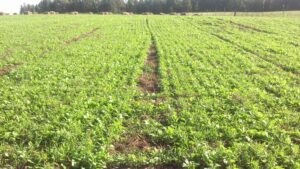
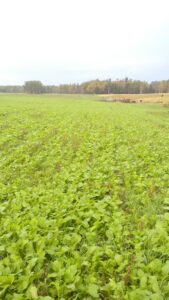
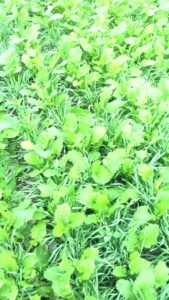

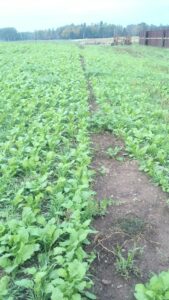
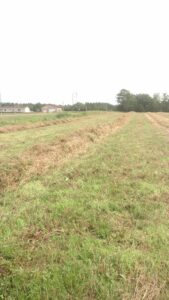
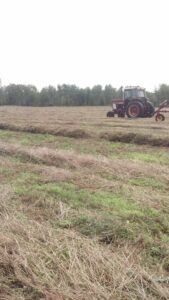
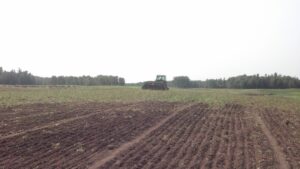
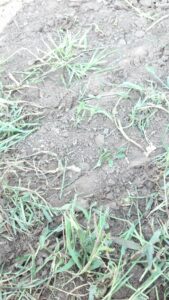
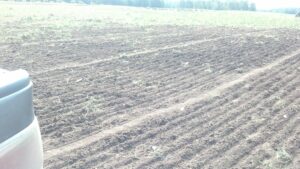
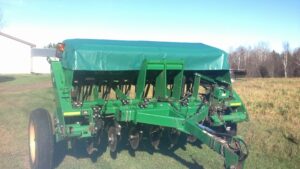

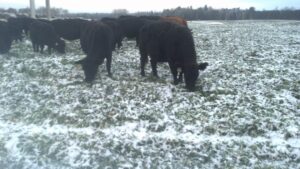



Some of the soils data in this project has been less than straight forward which has led to exploring information and resources from colleagues. The noteworthy aspects from 2015 soil data is how the control field had higher levels of available nitrogen and sulfur versus the treatment fields suggesting nutrient capture by plant growth. This was specifically demonstrated at the Salzer site. (See Table)
The problem for understanding came from the biological testing performed. This is a very complex subject area and therefore we relied on our local NRCS (Natural Resource Conservation Service) soil scientists and webinars presented to assist in analyzing the data. First, C:N ratio would be to plants as gas:air mixture would be in a gas engine. If too much or too little of each of the nutrients is provided, the system doesn’t work as it should. The typical range that was suggested for optimum mineralization should range from 8:1 to 15:1. In our testing, it ranged from 8:1 to 14.3:1 which would be considered good. No real differences were observed between treatment versus control on results at each of the research sites.
The next soil biological indication was the Solvita test (also referred to as a CO2 Burst test and CO2 ppm release) This procedure collects the amount of CO2 released from a given quantity of soil in a 24-hour period. As the soil biology increases so does the amount of CO2 released.
In 2014, the data had similar numerical differences at sites as well as within treatments but these difference most likely were not significant as the CO2 level was evaluated at a higher level of precision (ppm) or mg/kg. Therefore, these numeric differences may have been explained by something as simple as sampling error or as NRCS staff suggests ranges in comparison to the amount of CO2 released. In our sampling, all fell into the 60-80 ppm range which indicates moderately high activity.
In 2015, the same held true for all of the sites except for the Salzer site. The Solvita test indicated a significantly higher level in order of magnitude and also a significant difference in the control site (441.1ppm) versus the treatment site(703.2 ppm). This would suggest that the area growing the winter rye/ turnips did have more biological activity as we anticipated but might suggest excessive biological activity. The work left some unanswered questions based on what biological activity is taking place:
-
- Increased organic matter on the Salzer site was 10.3% to 11.2% which is very high.
-
- The addition of air into soil tillage – none was used before cover crop planting
-
- Saturated soils slow biological activity
-
- Excessively high carbon content slows biological activity (C:N ratio)
Therefore, our thoughts turned to whether the fact that the manure supplied by grazing of the oats and peas annual crop may have been a biological primer which was compounded over the two year study. Did this primer stimulate the response in both the control and the treatment?
This two year project has really just demonstrated how little we (farmers in the project) have an understanding of the impacts.
Over the period of the 2 year study, we determined that cover crops can be successfully implemented in a northern Minnesota climate in a variety of cropping systems. The project also clarified a list of suggested management techniques to improve the success of implementing cover crops including selecting cold tolerant cover crop seeds, planting as early as possible, addressing soil fertility issues, selecting fields conducive to productive grazing and plan for utilizing high quality forage.
Cover crops can extend the growing season while maintaining soil cover and providing opportunities to improve soil health for both grazing as well as cropping systems. Yields calculated were 1.14 tons to 2.28 tons of dry matter/acre on the Salzer farm and 1.34 tons to 1.58 tons of dry matter/acre at the Mach farm over the 2 year study.
Cover crops (winter rye and turnips) can produce the quality of feed necessary to adequately finish beef with grass/forage due to the levels of crude protein and digestible dry matter. Moisture content should be monitored to be sure that animals can physically consume enough forage to achieve adequate nutrient intake. Resolution might include supplementing with dry hay while grazing a cover crop.
Utilizing this species mix of cover crops has effectively produced inexpensive, high quality forage while still allowing animals to be grazed on average of 30 to 60 days. Costs per ton ranged from Salzer $23.82/ton (2015) to Mach $42.50/ton (2015). This compares to similar forage value ranging from $150-$180 per ton at DHIA hay auction results on 12/17/15. This would suggest that this will provide a very inexpensive option of supplying quality feed.
Although not demonstrated in this project, cooperating farmers intend to utilize a similar management technique for grazing season extension anticipating 2-3 weeks sooner in the spring due to a spring green up of winter rye. Also, the cooperating farmers intend to implement a more diverse mix of cover crops to encourage better soil health and opportunities for increased nutrient management.
Comments from Abe Mach in the fall of 2015 included, ”Winter Rye and turnip emergence was very good. Lack of vigorous growth suggests fertility issues. I go back in my mind to the common thread through all of this research: fertility, fertility, fertility! We can't build soil health and composition in a timely fashion without the nutrients! If we import the nutrients at the beginning and in a form that won't leach and is available, we can capitalize on recycling these nutrients through forage growth, and subsequent livestock utilization and trampling impact.”
Impact of Results/Outcomes
Outreach provided and will continue to provide a better understanding of soil health information and soil test data and how that can be evaluated. This project confirmed that growing cover crops can successfully capture nutrients being released from soil mineralization after annual crops are typically harvested. Our extensive photo gallery that was compiled shows growth patterns of cover crops in northern Minnesota on a variety of soil types providing a visual verification of the data (See Photo Gallery). The increased awareness through our outreach efforts will continue to provide options for producers to use cover cropping as part of their systems during the full season and post-harvest of annual crops. An awareness for local farmers was established for the potential value in considering diversity in mixes of species to address soil health. Due to the amount of data collected, we have become a local information source to growers and producers on this and other similar topics.
Educational & Outreach Activities
Participation Summary:
Abe Mach and Troy Salzer presented at Northeast Forage & Grassland Council Annual Meeting held on February 3, 2015. Research results and information from the field day in August 2014 at the Mach farm was provided in a summary handout (Attachment 1).
The handout was also utilized and information presented on a poster board display at the Carlton County Fair on August 13th -16th, 2015 as part of the University of Minnesota Extension education booth. This created further awareness of the project and how cover cropping can be incorporated into producers' operations as well as providing local citizens an awareness of the research activity and practices being implemented to preserve and enhance soil quality.
On September 8th, 2015 a cover crop tour was held at Abe Mach’s farm with presentations by both Abe Mach and Troy Salzer (See Cover Crop Tour 2015). They reviewed the abstract of the entire project and how it was implemented on Abe’s site as well as similar testing on the other two sites that have different soil types. Attendance was 23 farmers and neighbors plus 23 agency staff (Pine County SWCD, NRCS, St. Louis County SWCD and University of Minnesota Extension Committee members) allowing for very good dialog. The farmers each discussed how similar projects could be implemented on their farms. Additionally, participants brainstormed and conversed about:
-
- How to control seed costs yet increase diversity
-
- Why more diversity was not utilized in this project
-
- How to set a No-till seeder (Pine County SWCD provided their No-till drill for demonstration purposes)
-
- How important seed placement is for successful stand establishment
-
- Why calibration of drills is important and how calibration occurs
-
- How fertility comes into play for cover crop success
The event went late into the evening which indicates a great interest in the topic which was confirmed by the results of the event survey (Attachment 2).
Several opportunities to share the research results are planned for early 2016. Pine County SWCD will host a workshop in conjunction with NRCS on March 10th where Troy Salzer will present updated handouts and display items on the project highlighting data collected. Carlton County NRCS will host a similar workshop in April 2016 (date to be determined). The presentation will include not only why cover crops should be considered but also how to successfully implement cover crops with the challenges of a northern growing season. The results will also be presented NCR-SARE Farmers Forum at the Practical Farmers of Iowa 2016 Annual Conference set for January 22-23, 2016 in Ames. IA. The forum will allow Abe and Troy to present project processes and results to an audience of greater diversity.
In addition, articles were published in the January 2015 and January 2016 editions of the University of Minnesota Extension Connection circulating over 2400 copies quarterly. (See attached 2015 SARE Newsletter & 2016 SARE Newsletter)
Road signage remains in place at the Mach farm providing awareness of the project and an opportunity to share details of the project and results through on-site handouts continually accessible to interested parties.
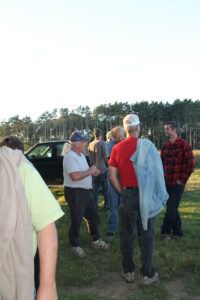
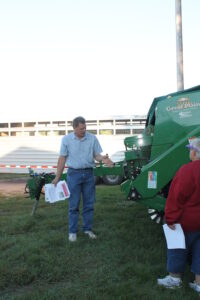
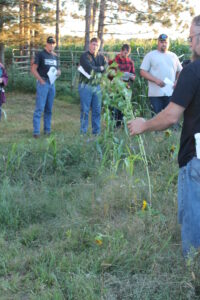
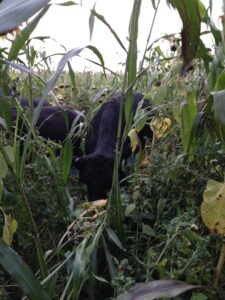
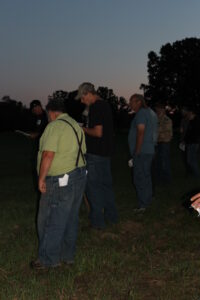
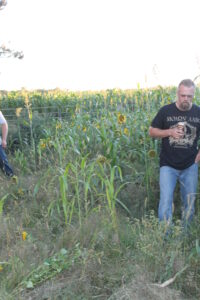
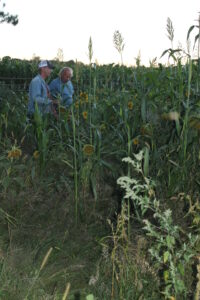
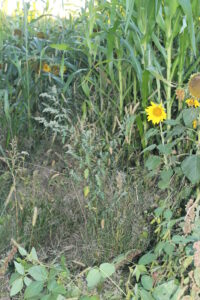

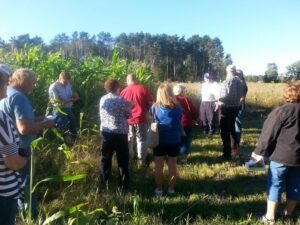
Project Outcomes
Potential Contributions
Cover crops can be successfully established in northern growing zones using a target seeding date for our area of early to mid-August very similar to fall seeded alfalfa. They can yield adequate forage to justify seed and fertilizer costs without even considering soil health value. Forage quality can be adequate for grazing season extensions for high nutrient demand animals such as finishing cattle, feeder cattle, dairy cows and feeder lambs or kids. However, one must keep in mind the very high moisture content potential at times. This project also successfully demonstrated how using cover crops captured nutrient in soil profiles as well as stimulated more biological activity in areas where cover crops were grown as opposed to where cover crops were not grown.
Future Recommendations
Our project left some unanswered questions:
- Is there a base line in which both nutrient and organic matter impacts soil organism to be stimulated into higher activity?
- How would having a more diverse cover crop impact Solvita test results?
- Does the use of grazing of harvest versus mechanically harvest impact soil biological activity during cover crop growth?
- Does the manure deposited on soil during annual crop grazing impact soil biological activity?
- How do we inform other farmers that if we take better care of our soil (pH, OM, diversity of crops, fertilizer, etc.) our soil will grow better crops?
- How can we develop a process for farmers to allow the time and resources to allow the planting of cover crops when other projects don’t allow for it in summer and fall harvest.